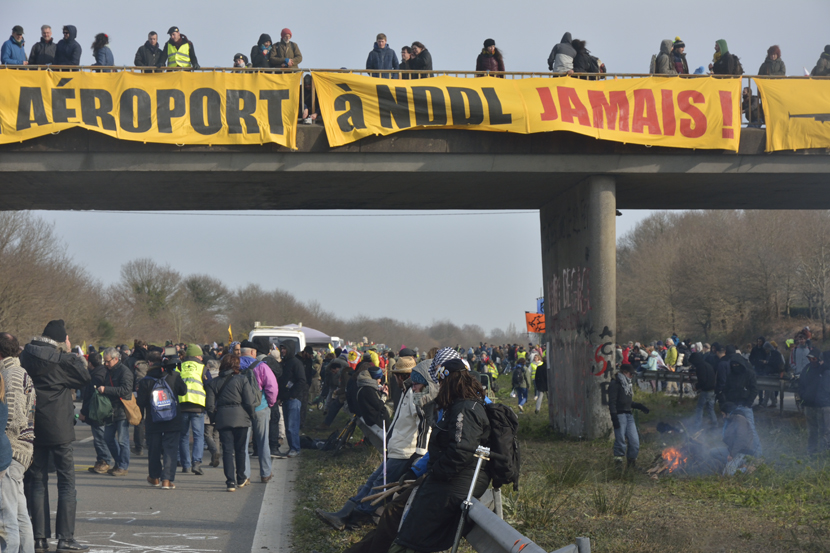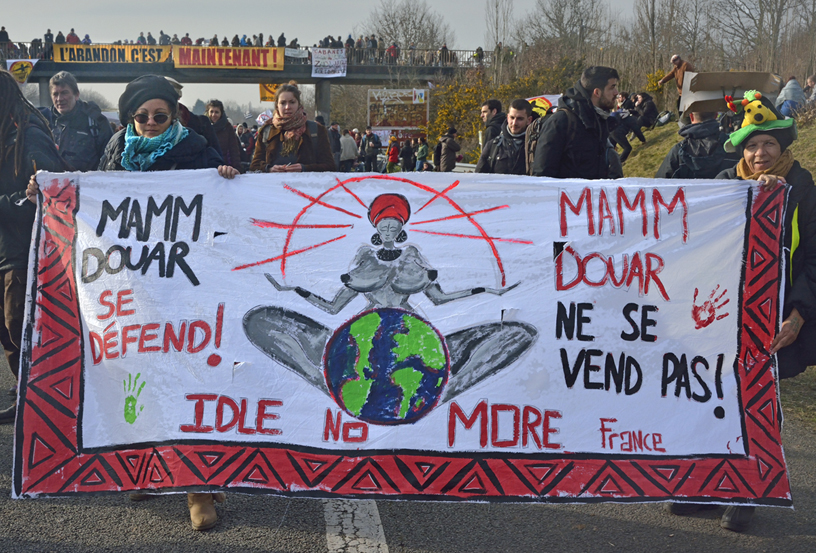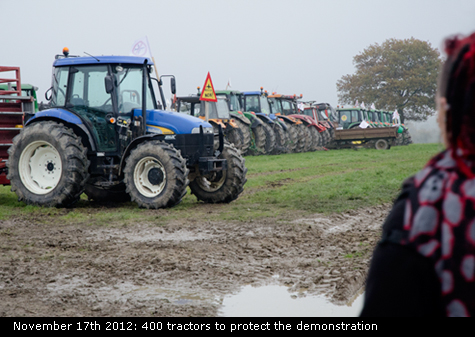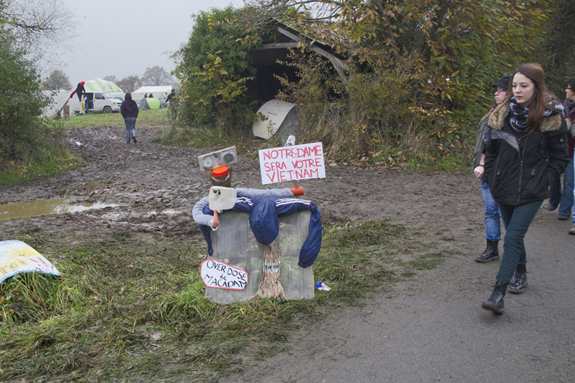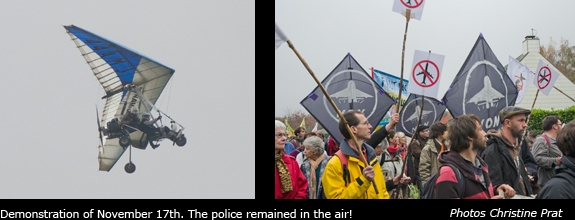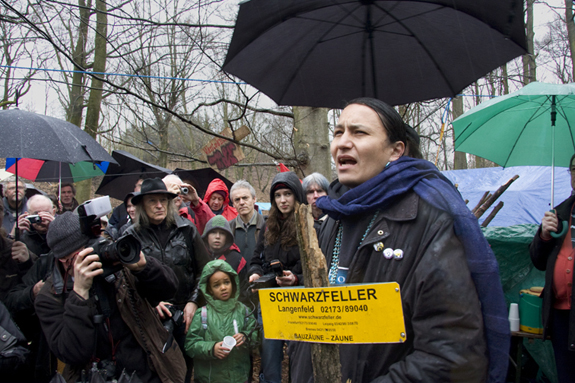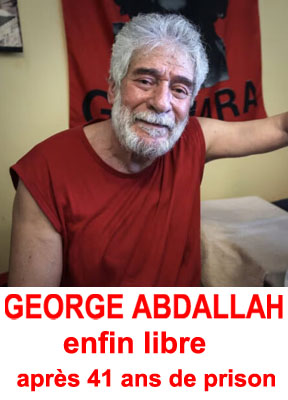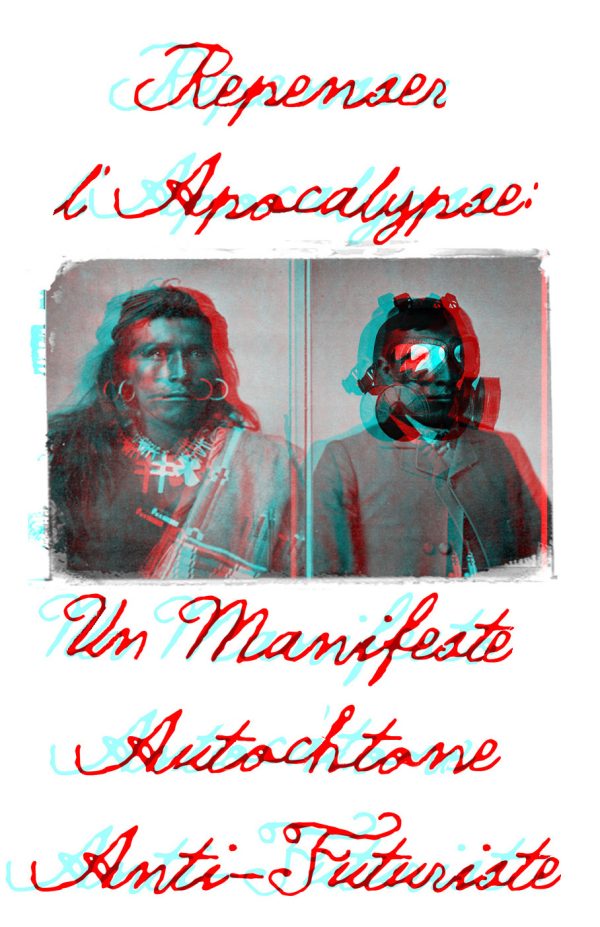LA MANIFESTAZIONE DI SABATO 27 FEBBRAIO 2016 IN DIFESA DI NOTRE DAME DES LANDES E’ STATO UN INDISCUTIBILE SUCCESSO
Emmanuelle Bramban, 1 marzo 2016
Traduzione in Italiano Benedetta Bassi
English
La manifestazione di sabato 27 febbraio 2016 per proteggere Notre Dame del Landes, area minacciata dal progetto distruttivo della costruzione di un nuovo aeroporto, è stata più che un successo.
Circa 60 000 persone da tutta la regione e anche da tutta la francia sono venute per sostenere i movimenti di resistenza locale, quelli dei contadini come quelli de la ZAD!
Nonostante i poteri al governo stiano cercando di minimizzare questa enorme mobilitazione, piaccia o no, è stato un raduno gigantesco, il più importante dell’intera storia di lotta per Notre Dame des Landes.
Due convogli dalle regione di Parigi sulla strada verso il punto di incontro, una da Saint-Denis- dove l’amministrazione comunale ha finanziato l’affitto di autobus in solidarietà, l’altro da Parigi e consisteva in 8 enormi autobus pieni.
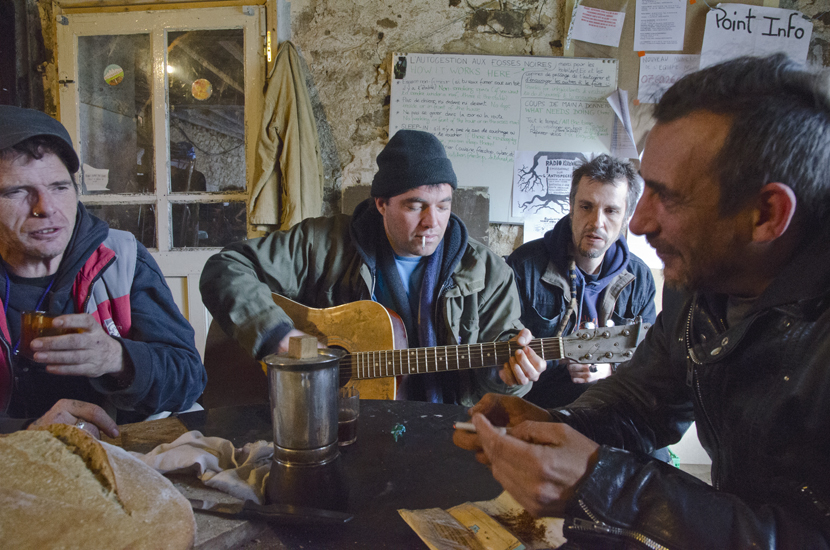 Da Larzac, una regione storicamente nota per la resistenza contadina, da Languedoc nel sud, dalle regioni lungo il Rodano, da Alsace ad est, dal Nord etc, da tutte le regioni della Francia ma anche dall’Inghilterra, l’Irlanda, in piccole e grandi delegazioni, essere umani hanno pensato fosse importante difendere quel pezzo di Francia, la terra ancestrale, ricca e bella, contro il progetto insensato di costruire un aeroporto per mano della compagnia Vinci.
Da Larzac, una regione storicamente nota per la resistenza contadina, da Languedoc nel sud, dalle regioni lungo il Rodano, da Alsace ad est, dal Nord etc, da tutte le regioni della Francia ma anche dall’Inghilterra, l’Irlanda, in piccole e grandi delegazioni, essere umani hanno pensato fosse importante difendere quel pezzo di Francia, la terra ancestrale, ricca e bella, contro il progetto insensato di costruire un aeroporto per mano della compagnia Vinci.
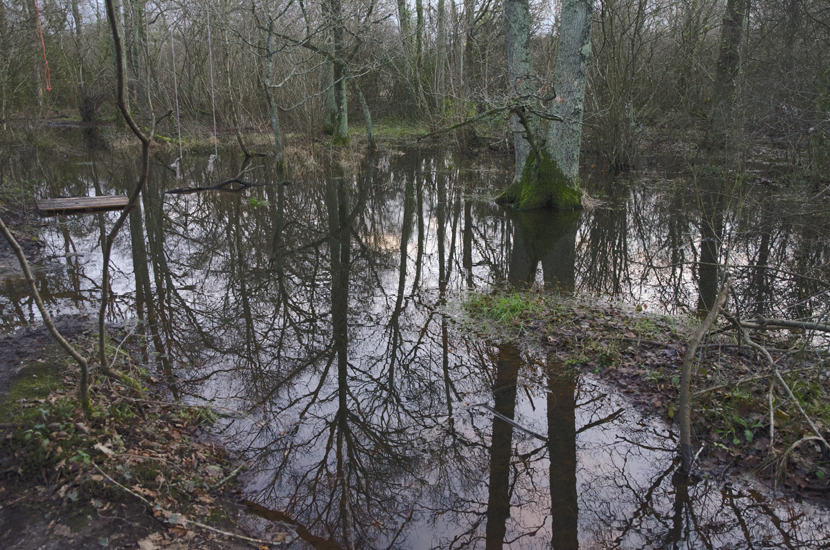 Un progetto che è stato voluto e ferventemente desiderato da Jean Marc Ayrault (ex primo ministro, ex sindaco di Nantes, adesso di nuovo ministro) e dal primo ministro Manuel Valls, questo è il motivo per cui sono pronti a sacrificare ed uccidere quella fiorente aera agricola con una straordinaria biodiversità che incluede specie protette ed una terra incredibilmente fertile.
Un progetto che è stato voluto e ferventemente desiderato da Jean Marc Ayrault (ex primo ministro, ex sindaco di Nantes, adesso di nuovo ministro) e dal primo ministro Manuel Valls, questo è il motivo per cui sono pronti a sacrificare ed uccidere quella fiorente aera agricola con una straordinaria biodiversità che incluede specie protette ed una terra incredibilmente fertile.
E a quel punto a la ZAD (Zone A Défendre: Zona da Difendere) quelli che occupano la terra intendono difenderla con la resistenza, la creatività si è sviluppata e nuovi modi di vivere orientati all’autonomia, all’autosufficienza alimentare sono state reinventatio in tante declinazioni. Questo è ovviamente qualcosa di pericoloso per le lobbies corporative che vengono difese incondizionatamente dal governo e dal Presidente, che vuole distruggere la forte resistenza di questa regione, per esempio reprimendo qualsiasi forma di dissenso.
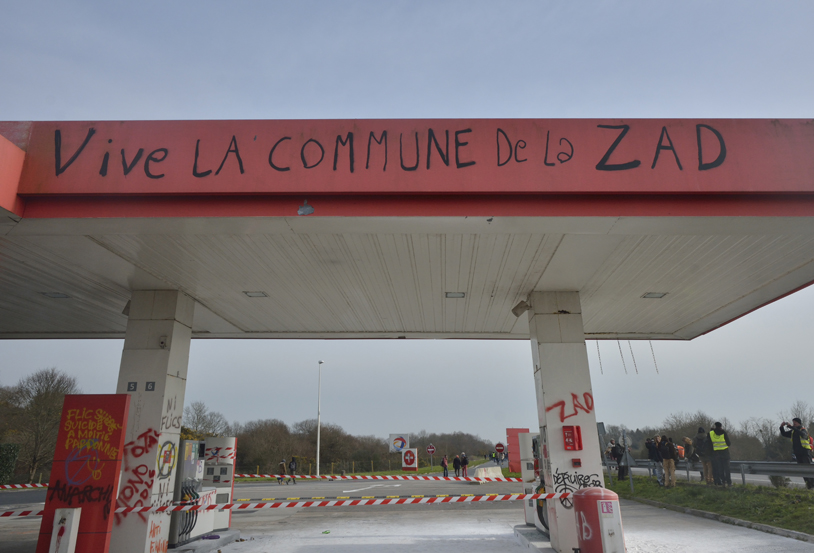 Sono andati così oltre per sgomberare da Notre Dame des Landes da esercitare pressioni sulle famiglie di contadini che ancora vivono nelle loro fattorie, quelle persone che vengono definite “la gente storica di NDDL”. Recentemente, la Corte amministrativa di Nantes ha deciso lo sgombero immediato dalle loro case e dalla terra della loro famglia da diverse generazioni. Quelle persone hanno chiesto di incontrare il Presidente, ma non hanno mai ottenuto risposta.
Sono andati così oltre per sgomberare da Notre Dame des Landes da esercitare pressioni sulle famiglie di contadini che ancora vivono nelle loro fattorie, quelle persone che vengono definite “la gente storica di NDDL”. Recentemente, la Corte amministrativa di Nantes ha deciso lo sgombero immediato dalle loro case e dalla terra della loro famglia da diverse generazioni. Quelle persone hanno chiesto di incontrare il Presidente, ma non hanno mai ottenuto risposta.
Quindi questo sabato, nell’intersezione di Vigneux a quella di Temple de Bretegne sull’autostrada 165, sono tutti arrivati chi camminando, chi in bici, chi sui trattori, spingendo carrozzine,
e tutti loro con uno spirito allegro e famigliare, ma molto determinato, esprimendo le loro istanze cantando “NO! NE’ AEROPORTO NE’ DISLOCAZIONE!” PARCHI NON CATRME… IL CIELO E’ DEGLI UCCELLI e l’hanno fatto in maniera artistica e creativa.
Questa terra e i suoi abitanti meritano di vivere e preservare il loro territorio ancestrale che è un beneficio per la regione e per l’intera Francia, è ora che il Presidente e il suo Governo riprendano la ragione e il senso della vita sulla terra e la smettano con la loro fame di denaro mortale.
Emmanuelle Bramban, 1 marzo 2016
Traduzione in Italiano Benedetta Bassi
GATHERING ON FEBRUARY 27, 2016, TO PROTECT NOTRE DAME DES LANDES WAS A CLEAR SUCCES
By Emmanuelle Bramban, Idle No More France,
March 1st 2016
Translation by Christine Prat
Italiano
The gathering on Saturday February 27, 2016, to protect Notre Dame des Landes, threatened by the destructive project to build a new airport, was more than successful.
Some 60 000 people from all over the region and even all over France came to support local resistance movements, those of farmers as well as that of the ZAD!
Whether the governing powers, who try to minimize this huge mobilization, like it or not, it has been a huge gathering, the most important in the whole history of the struggle for Notre Dame des Landes.
Two convoys from the Paris region took the direction of the meeting point, one from Saint-Denis – where the city council financed the hiring of busses in solidarity – the other from Paris, consisting of 8 big busses, all full.
From Larzac, a historical farmers’ resistance region, from Languedoc in the South, from regions along the Rhone, from Alsace in the East, from the North… etc., from all regions of France, but also from England, Ireland… in big or small delegations, human beings found it important to defend that small piece of France, that ancestral land, rich and beautiful, against that senseless project of having an airport built by the Vinci company.
 A project which has been wanted and fervently desired by Jean-Marc Ayrault [ex-Prime Minister, ex-Mayor of Nantes, now Minister again] and Prime Minister Manuel Valls, this is the reason why they are ready to sacrifice and kill that rich agricultural area with an extraordinary biodiversity including protected species, and an incredibly fertile soil.
A project which has been wanted and fervently desired by Jean-Marc Ayrault [ex-Prime Minister, ex-Mayor of Nantes, now Minister again] and Prime Minister Manuel Valls, this is the reason why they are ready to sacrifice and kill that rich agricultural area with an extraordinary biodiversity including protected species, and an incredibly fertile soil.

And then on the ZAD (Zone A Défendre: To be Defended Area), where those who occupy the land mean to defend it through resistance, creativity has been developing and new ways of life tending to autonomy and food self-sufficiency have been reinvented in numerous ways. This is necessarily dangerous for corporate lobbies which are unconditionally defended by government and Presidency, who want to break this strong regional resistance, as an example to crush any further dissent.
They have gone so far as to exert pressure to remove farmer families from Notre Dame des Landes who are still there in their farm – those who are called the ‘historical people of NDDL’. Recently, the administrative court in Nantes decided their immediate removal from their houses and their family lands which they have owned for several generations. Those people have been asking for years to meet the President who never answered.
Thus, that Saturday, from intersection Vigneux to that of Temple de Bretagne on highway 165, they all came walking, cycling, on tractors, pushing  prams, and all of them, in a cheerful family-like mood, but very determined, expressed their will, chanting “NO! NEITHER AIRPORT NOR RELOCATION!”, “GARDENS, NO TAR”, “THE SKY FOR THE BIRDS!” as well as in artistic, creative ways.
prams, and all of them, in a cheerful family-like mood, but very determined, expressed their will, chanting “NO! NEITHER AIRPORT NOR RELOCATION!”, “GARDENS, NO TAR”, “THE SKY FOR THE BIRDS!” as well as in artistic, creative ways.
This land and its inhabitants deserve to live and to keep their ancestral territory which is a benefit for the region and the whole of France; it is thus time that the President and his government come back to their senses and to the reason of the Life of the Earth and stop giving in to the calls of deadly cash.
Emmanuelle Bramban, March 1st 2016
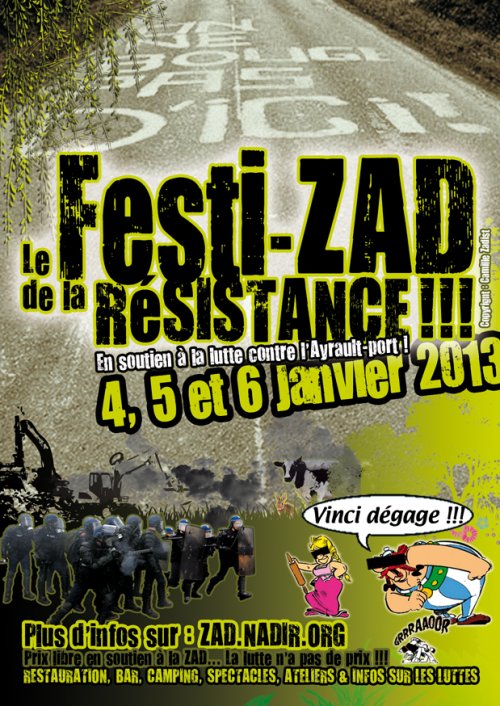 By Christine Prat (See previous article)
By Christine Prat (See previous article)
January 8th, 2013 – The anti-airport struggle reached a climax last weekend – January 4th, 5th, 6th – with a festival that attracted between 8000 (according to police) to 30000 (according to organizers) visitors and supporters, despite of hard conditions. Following the November 17th demonstration during which 5 cabins– a meeting place, two dormitories, a sanitary block and a workshop (CQFD nr 106, December 2012) – were rebuilt under the protection of demonstrators and local farmers, the authorities banned all transport of building materials to the area, so that the police blocked the vehicles bringing materials to put up stages and tents for the festival, as well as the vehicles bringing food and drinks. The weather was rather bad, some people got stuck in the mud up to their knees and could only come out by leaving their boots buried in the mud.
Prime Minister Ayrault, supported by President Hollande, still mumbles that the project will be realized anyway. However, resistance and support keep growing. Locally, solidarity between activists and local farmers and inhabitants grows stronger. A member of the ACIPA (local association of directly impacted citizens) told CQFD: “… Most of all, there is one achievement: having been able to organize into one general meeting, despite of some clashes and different political cultures!”… “Illegal occupation of the area somehow became legitimate and moreover, those young people brought in their very democratic ways of working.” (CQFD nr 106, December 2012). On November 17th, farmers brought some 400 tractors to protect the demonstration and the rebuilding of cabins. They left tractors chained to each other around the cabins to block bulldozers and police vehicles.
Further, support is quickly growing. In November there were already over 140 local support committees all over France, as well as two in Belgium (Brussels and Liege). Support demonstrations take place every Saturday in Nantes and in many cities and towns in France. Many actions have been organized against the building corporation Vinci, which is supposed to build and manage the airport. They already own or manage motorways and parking lots all over France, so that protesters could organize local actions against the corporation by blocking toll booths on motorways and at parking exits, letting vehicles go through without paying, until the police arrived. In places, the connection has been made with other struggles: for instance, in Bordeaux, the DAL – “Right To Housing”, an association that demands housing for all and squats empty buildings to house homeless families – occupied an empty building together with anti-airport protesters. Support is also coming from individuals and groups from the UK, Italy, Germany, etc.
“Long Walks” towards Notre-Dame-des-Landes have been or are being organized. People left from Nice at the beginning of December, walking all day and sleeping in villages where they are housed by supporters. Others left from Lyon, and more recently from Lille. They are supposed to converge on the site at the beginning of February. In December, people cycled to Notre-Dame-des-Landes from the Ardèche, in South-eastern France.
There are also demonstrations and support actions for the people who have been arrested on the site, especially for one individual who was immediately brought to court, convicted, sentenced to 5 months and has been in jail ever since. He and several other persons were arrested at a blockade where a police infiltrator was present. Money is being raised for their legal defense.
Many more events are scheduled, more will be improvised. It’s not over! Many other struggles against other controversial projects – which have not yet got as much media coverage as Notre-Dame-des-Landes – are still going on.
Sources:
https://zad.nadir.org/?lang=en (in English)
CQFD nr 106, December 2012
Le Monde Diplomatique, nr 706, January 2013
Few photos of the Festizad available, you can see a video on:
http://www.rennestv.fr/catalogue/web-tv/festizad-woodstock-notre-dame-des-landes.html
Notre-Dame-des-Landes, 17 novembre Photo Christine Prat
28 novembre 2012
By Christine Prat
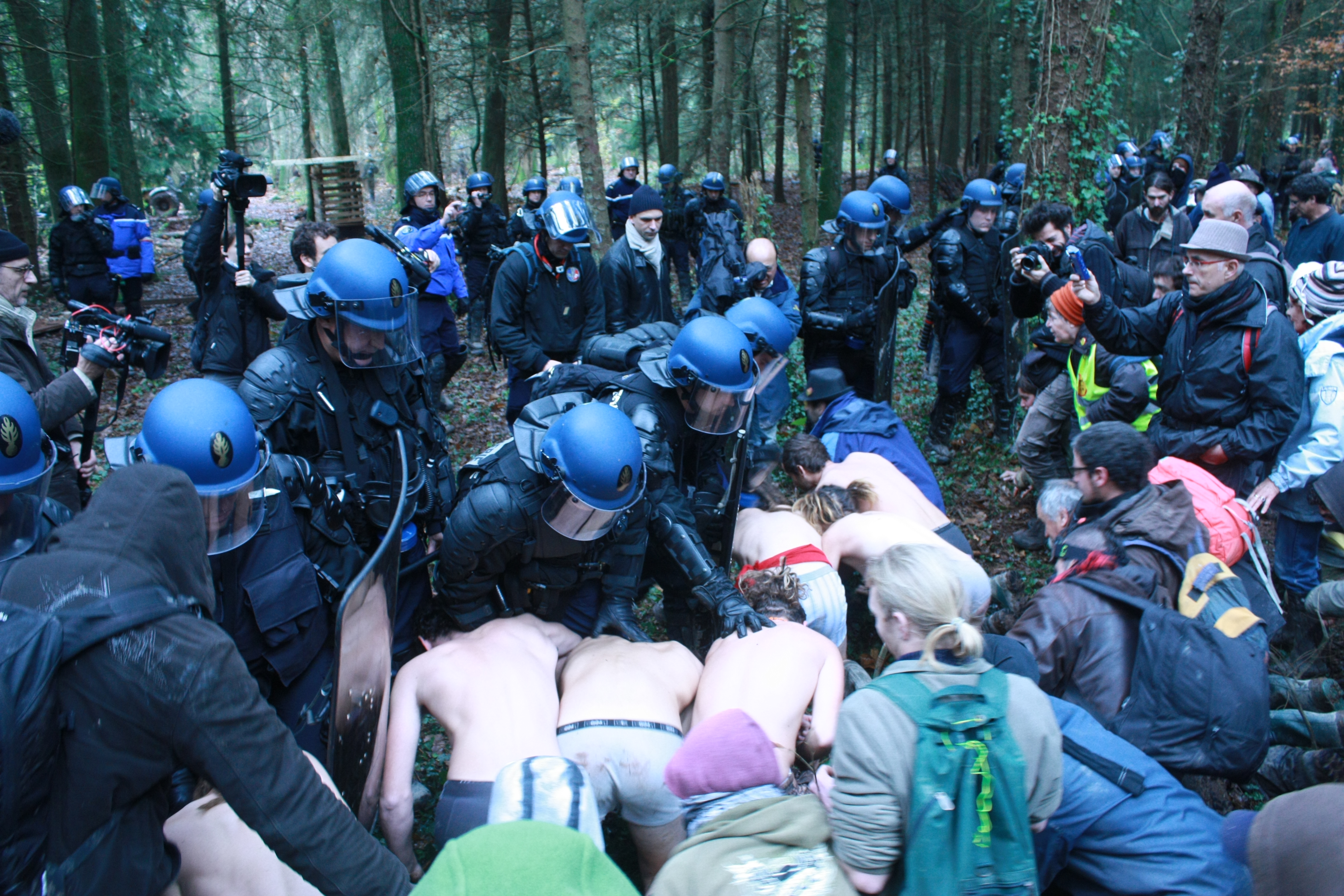
Photo http://lazad.noblogs.org/photos/
During the weekend of 23-25 November, violent clashes have occurred, as the military police attacked activists on an area slated for an airport project in Notre-Dame-des-Landes – a village near Nantes, while the riot police violently dispersed a support demonstration in the center of Nantes. Unfortunately people were wounded, some seriously. However, the events have forced the national and corporate media and their politicians to publicly admit that there is an issue: all day long they broadcast – distorted – news and – prejudiced – debates and interviews.
Some forty years ago, the French State and the local authorities devised the project of building a huge, international airport some 20 miles north of Nantes. The incredible sum of money necessary for the project was not available at the time so that the works never started. However, in 1974, the French Government reserved the area, declaring it ‘Differed Development Zone’ which meant that no building permit could be delivered on it. It protected the area from the then quickly developing agro-industrial business and urbanization craze, so that Nature took over the not privately owned areas – birds came back – while small farmers could go on with traditional agriculture on their private plots.
The area is a wetland. The importance of wetlands for the global climate has been discovered in between, so that French Law now demands that corporations and institutions destroying wetlands for their projects create others of the same size in the region or elsewhere in the country.
In the mid 2000 years, the project was dug out of forgiveness, mainly supported by the long time mayor of Nantes, Jean-Marc Ayrault, who became Prime Minister of France a few months ago, in the wake of the national elections. The main contractor of the public-private partnership is the building corporation Vinci, which has also been contracted to build the East End Crossing (Le Figaro, 21-11-2012), a bridge over the Ohio River, from Louisville, Kentucky, to South Indiana, and the Atlantic Bridge in Panama (Le Figaro, 15-11-2012). The ‘Préfet’ – local representative of the Ministry of Interior – who was in charge until 2009 and supported the airport project, immediately got a position at Vinci as soon as his official mandate expired, so that opponents suspect that he was already working for the corporation in his quality of civil servant. Vinci does not provide for the creation of a new wetland area in its project, which makes it illegal. Proponents try to minimize the problem by saying that it is the “only” issue which is not solved, but, as a matter of fact, it is a MAJOR issue that makes the whole project unlawful.
When the project was devised, kerosene was still cheap, and, on the basis of the development of air traffic at the time, they calculated that the existing Nantes airport would be saturated by 1983-84. However, in 2012 Nantes airport is still working at only 75% of its capacity.
Resistance
The project sunk into forgiveness, so that the initial resistance of local farmers and inhabitants dwindled away. But when it was dug out of the administration files in 2005, the directly impacted people formed the ACIPA, Inter Communal Association of Impacted Populations, which organized a ‘Week of Resistance’, showing documentaries, organizing debates and music shows. Then opponents decided to occupy the area, to settle in abandoned houses and to build cabins in the woods. As stated in CQFD, a Marseille based monthly, “Local opponents called for an occupation of the zone. Then we started to open the place, to occupy deserted houses, to settle in the woods, to build cabins. And then the acronym ZAD (for “Differed Development Zone”) became ‘Zone A Défendre’ (Zone to be defended)” says Kevin who has been living there for three years “[…] Some people have collective gardens to produce vegetables and onions, for instance. Others are more individualistic. A vegetable farm produces big quantities. A baker makes bread for free price twice a week. A farmer makes goat cheese. Some spent years building housing. Abandoned houses have been rehabilitated. Workshops are devoted to repairing cars and bicycles. A theater was built. There are libraries and a newspaper spreading news about the activities of the 35 sites on the area. We had shows. We use our cars to pick up wasted materials and food from supermarkets. That food is given out and left in a place called La Planchette so that everybody can help themselves.” (CQFD nr 105 – novembre 2012).
The diverse resisting groups were never united. The farmers and inhabitants were suspicious and reluctant to ally with environmentalist activists or anarchist squatters. Even the activist groups were quite different from each other: Caroline, quoted in CQFD, said: “[…] We are all anti-productivist, anti-capitalist, anti-authoritarian, and our common wish is to live differently, but our ways of doing it are different, according to each of us. Some live in cabins in the trees. Others are in houses with a relative comfort where anyone can help himself. […]” (CQFD nr 105 – novembre 2012).
Then, on October 16th, military police attacked the site, destroyed cabins and removed settlers. The diverse groups of resisters began to come closer to each other. In the following days, police harassment went on. Local farmers and inhabitants dropped their suspicion toward activists and declared their solidarity.
On November 17th, a huge demonstration (some 38000 people, from all over France and other countries) took place on the area. Political stars from the so-called ‘green’ and ‘leftist’ parties rushed to the spot to recuperate the struggle. But they were not allowed to make speeches. The demonstration was seen as a victory by the resisters.
Then, on Friday November 23rd, the military police violently attacked the area, fighting through the next day. On Saturday 24th, a demonstration in the center of Nantes was also violently attacked, in front of the Prefecture.
It was quite a shock. Some elected politicians locked themselves to the gates of the Prefecture to protest against the police action. Members of the Green parties in the government got a six months postponement of the project to allow an environmental impact study. The resisters are not convinced and demand that police be kept away from the area before they accept to discuss with the authorities.
See:
http://zad.nadir.org/spip.php?article656
http://actualutte.com/livenddl/
http://www.cqfd-journal.org/
Daily infos in English on the activists’ site:
https://zad.nadir.org/?lang=en
March 2009, Blackfire, on tour in Germany, expressed their support to German protesters struggling against the extension of Frankfurt airport. Many musicians also support the struggle in Notre-Dame-des-Landes, among others our friends of Haymarket and Trouz An Noz.
Photo Christine Prat

